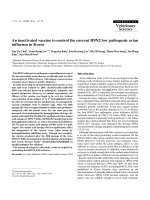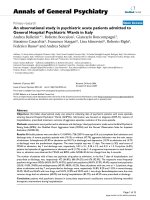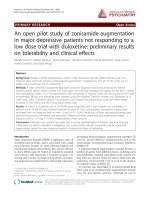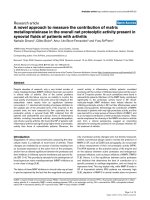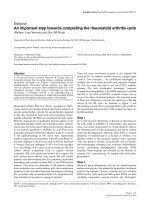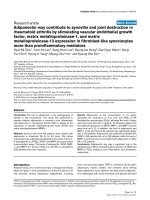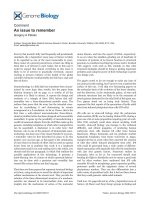Báo cáo y học: "An innovative method to evaluate the suture compliance in sealing the surgical wound lip"
Bạn đang xem bản rút gọn của tài liệu. Xem và tải ngay bản đầy đủ của tài liệu tại đây (531.63 KB, 7 trang )
Int. J. Med. Sci. 2008, 5
354
International Journal of Medical Sciences
ISSN 1449-1907 www.medsci.org 2008 5(6):354-360
© Ivyspring International Publisher. All rights reserved
Research Paper
An innovative method to evaluate the suture compliance in sealing the
surgical wound lips
Farid Saleh
1
, Beniamino Palmieri
2
, Danielle Lodi
2
, and Khalid Al-Sebeih
3
1. Department of Anatomy, Faculty of Medicine, Health Science Centre, Kuwait University, Kuwait.
2. Department of General Surgery and Surgical Specialty, University of Modena and Reggio Emilia, Surgical Clinics, Via del
Pozzo, 71, 41100 Modena, Italy.
3. Department of Surgery, Head and Neck Surgery, Faculty of Medicine, Health Science Centre, Kuwait University, Kuwait.
Correspondence to: Dr. Farid Saleh, Department of Anatomy, Faculty of Medicine, Health Science Centre, Kuwait University, P.O. Box
24923, Safat 13110, Kuwait. Fax: +965/ 5319478, E-mail:
Received: 2008.10.23; Accepted: 2008.11.07; Published: 2008.11.11
Background and aim: The increasing number of surgical procedures performed with local anesthesia, followed
by immediate patient discharge from the hospital, emphasizes the need for a tight waterproof suture that is ca-
pable of maintaining its tensile strength in the postoperative phase when the wound tumescence, edema due to
the anesthetic drug, and surgical trauma disappear. Moreover, the issue of having an accurate surgical wound
closure is very relevant in vivo in order to prevent hemorrhage and exogenous microbial infections. This study
aimed at designing a new a lab technique that could be used for evaluating the best surgical material. Using such
a technique, we compared the wound-lip-sealing properties of three commonly-used suture threads, namely
polyurethane, polypropylene, and polyamide.
Materials and methods: The mechanical properties of same-size suture threads made from polyurethane, poly-
propylene, and polyamide, were compared in order to define the one that possess the best elastic properties by
being able to counteract the tension-relaxation process in the first 12 hours following surgery. The tension hold-
ing capacity of the suture materials was measured in both in vivo and in vitro experiments. The surface area of the
scar associated with the three different suture threads was measured and compared, and the permeability of the
three different suture threads was assessed at 0 minute, 2 minute, 4 minute, 6 minute, and 8 minute- interval.
Results: Results showed that polyurethane suture threads had significantly (P < 0.05) better tensile strength,
elongation endurance before breakage, and better elasticity coefficient as compared to polypropylene and
polyamide suture threads. Moreover, polyurethane suture threads were significantly (P < 0.05) more imperme-
able as compared to the other two suture thread types (polypropylene and polyamide). This impermeability was
also associated with a tighter wound-lip-sealing ability, and with significantly (P < 0.05) less scar formation.
Conclusion: Among the main concerns that surgeons, physicians, and patients often have is the development
infection, oozing, and scar at the incision site following suturing. This always raises the question about which
suture to use to avoid the above problems. This study provides evidence that the new technique developed in
our lab could be used to compare the wound-lip sealing properties of different surgical suture threads. Using
such a technique, the results show that polyurethane is significantly better than other commonly-used suture
threads, like polypropylene and polyamide, in relation to wound sealing and scar formation.
Key words: suture threads, polyurethane, polypropylene, polyamide, wound-lip-sealing properties
INTRODUCTION
There are different types of suture threads that
are being used for tissue closure in different types of
surgeries and invasive procedures (Table 1) [1, 2]. The
mechanical characteristics of suture lines depend on
the intrinsic nature of the suture material used [3, 4, 5].
Such characteristics include tensile strength, smooth-
ness, memory, and elasticity.
The tensile strength of a suture often used for
tissue closure is defined as the amount of weight re-
quired to break the suture, divided by the suture’s
cross-sectional area [2]. The cross section of the suture
is conventionally measured by the size of the suture
threads from 0 to 1 / 0, 2/ 0, 3/0, etc., and the smaller
the size of the suture the milder would often be the
inflammatory process due to reduced foreign body
reaction [2, 5]. Accordingly, the surgeons always have
Int. J. Med. Sci. 2008, 5
355
the challenge of being able to select the thinnest suture,
especially the one with non-absorbable material, pos-
sibly non-filamentous, easy to be tied, and easily and
painlessly removed.
Table 1: A summary of the most commonly used sutures.
Material Configuration Tensile strength Absorption
time
Knot Use
VICRYL RAPID: glycol and lactide
copolimer coated by polyglactin 370
and Ca
++
stearate
braided 45% at 7 days 50 days good Subcutaneous and cutaneous clo-
sure, pediatric, and obstet-
rics-gynecology
VICRYL COATED: glycol and lactide
copolymer coated by polyglactin 370,
910 and Ca
++
stearate
braided 65% at 14 days 50-70 days good not for tissue continuously
stressed
MONOCRYL: glycolide and epsilopn
caprolacton copolymer
monofilament 50% at 14 days 105 days good Obstetrics- gynecology, urology,
plastic, abdominal, and vascular
POLYDIOXANONE: ester polymer monofilament 70% at 14 days 200 days poor Abdominal, thoracic, subcutane-
ous, intestinal, vascular, pediatric,
plastic, oncology, orthopedic
PANACRYL: glycolide and lactide
copolymer coated by caprolactone and
glycolide
braided 80% at 3 months 18-24 months good Tendons, ligaments, and articular
capsules
SURGICAL GUT (plain) twisted poor at 7-10 days 6-8 weeks poor Subcutaneous closure, and closure
of punch biopsies
SURGICAL GUT (fast-absorbing) twisted 50% at 3-5 days 2-4 weeks poor Subcutaneous closure
SURGICAL GUT (chromic) twisted poor at 21-28
days
8-10 weeks poor Subcutaneous closure, and vessel
ligature
COTTON twisted good / good None
SURGERY SILK braided/twisted none in 1 years / excellent General, ophthalmic, and plastic
surgeries
SURGERY STEEL: metallic alloy of
steel-nickel-chrome
mono/multifilament indefinitely / poor Abdominal and cutaneous sur-
geries, tendon repair, orthopedics,
and neurosurgery
NYLON: polyamide polymer monofilament 20% per years / good Skin closure, blood vessel ligature,
and plastic and ophthalmic sur-
geries
NUROLON: polyamide polymer monofilament indefinitely / good Skin closure, general, cardiovas-
cular, and plastic surgeries
PROLENE: propylene polymer monofilament indefinitely / good Skin closure, subcuticular, general,
plastic, cardiovascular, and oph-
thalmic surgeries
MESILENE: tereftalic acid and poly-
ethylene polymer
braided indefinitely / very
good
Skin closure, general, cardiovas-
cular, and plastic surgeries
ETHIBOND EXCEL: tereftalic acid
and polyethylene polymer coated by
polybutilate
braided indefinitely / very
good
Skin closure, general, cardiovas-
cular, and plastic surgeries
PROVOVA: polyvilden-
fluoro-exafluoropropylene polymer
monofilament indefinitely / very
good
Skin closure, plastic, ophthalmic,
general, cardiovascular, and plas-
tic surgeries
NOVARFIL: polybutester polymer monofilament indefinitely / good Skin closure
POLYURETHANE: polyurethane
polymer
monofilament indefinitely / very
good
Skin closure, general, cardiovas-
cular, and plastic surgeries
The smoothness of the suture results from the
molecular characteristics of its thread, or from a spe-
cific treatment of its surface that helps in reducing
tissue trauma when the suture is passing across the
wound margins [5, 6]. It is related to the knot strength
which is expressed by the friction coefficient, and to
also the resistance force produced by the
cross-sectional deformity of the threads [2]. Using the
“pull-out friction test”, it is possible to define silk as
the gold standard suture material in terms of knot se-
curity because of its high static withdrawal resistance
under low loads and relatively low dynamic with-
drawal resistance under high loads [6]. In high tension
wounds, the usage of greater tensile strength and knot
security is advisable. The choice is to use multifilament
not absorbable suture threads like silk, but the sur-
geons sometimes prefer the usage of absorbable long
standing suture threads that are buried under the skin,
thus holding the margins tightly and reducing the tag
of the tans-cutaneous epidermal suture threads [7, 8].
A suture pull-out tester includes a load cell assembly, a
drive track, a jig and a drive assembly. The load cell
assembly has a force measuring device and an at-
tachment member for retaining one end of a filament.
Int. J. Med. Sci. 2008, 5
356
The jig includes a receptacle dimensioned to receive a
suture package. The jig is driven along the drive track
by the drive assembly such that the attachment mem-
ber draws the filament from the suture package. The
force measuring device measures the forces required to
withdraw the filament from the suture package.
Suture memory and elasticity are inter-related.
The former is defined as its ability to return to its
original shape after being manipulated. The latter is
defined as its property to elongate when the tissue is
swollen, as it usually happens with surgical trauma,
and to return to the previous length after the tension
force is withdrawn [8]. The elastic property of the su-
ture can prevent skin strangulation or necrosis, which
often result in permanent scars. The suture thread
should be stiff enough to hold steadily the knot
avoiding slacking, but, also should have some elastic-
ity to counteract the tension to which the wound mar-
gin is often exposed [8].
Ideally, a suture should be inert, that is not
chemically-reacting with the environment, biocom-
patible, that is lacking pyrogenic and antigenic prop-
erties, and possibly capable of counteracting bacterial
colonization along the suture track [9]. Infection is of-
ten considered as the worst complication of a sutured
wound, and bacteria usually multiply in the area
where necrosis is present or where blood is being
pooled into the wound bed [9]. Once again, the suture
knot plays a pivotal role in this process, whereby ne-
crosis of the skin (especially in trauma wounds, or in
dystrophic elderly skin) can be induced if it is too tight.
On the other hand, if the suture knot is too relaxed, the
wound line will not be not sealed enough to prevent
infiltration of microbes or other foreign bodies [9, 10].
Wound infections are usually exogenous in ori-
gin, but some predisposing factors, such as poor hy-
giene, contamination of the suture material, wound
hematoma, or necrotic tissue (sometimes due to ex-
ceeding traction of the suture or poor vascular supply)
favors exogenous or endogenous bacterial prolifera-
tion [10]. In this study, another relevant risk factor was
introduced, namely unfitness (incomplete sealing off)
of the wound-lip margin due to suture relaxation in
the first 24 hour postoperative. This phenomenon is
very relevant, especially when local anesthesia is per-
formed in an outpatient-day-surgery procedure [11].
In the latter, the tissue surrounding the wound is
swollen due to subcutaneous drug injection. This re-
sults from vasodilatation that is drug-induced. Such
vasodilatation, in addition to the surgical trauma, often
last between 8 and 24 hours post-op. This is followed
by a gradual recovery of the tissue volume to the initial
baseline [11]. Accordingly, the ideal suture thread
should maintain a perfect wound closure, by having
enough elastic properties to hold the knot while
maintaining tensile strength either in the swollen or in
the late decongestive phase of the surgically-injured
tissue.
This study aimed at designing a new a lab tech-
nique that could be used for evaluating the best sur-
gical material. Using such a technique, we compared
the wound-lip-sealing properties of three com-
monly-used suture threads, namely polyurethane,
polypropylene, and polyamide.
MATERIALS and METHODS
Suture materials
Identical size (0.2 mm of thickness and 450 mm of
length.) monofilament suture threads were chosen for
the study. These included 25 polypropylene
(ASSUPRO) suture threads, 25 polyurethane
(ASSUPLUS) suture threads, and 25 polyamide
(ASSUNYL) suture threads (FabbrAssut Europe,
Magliano dei Marsi AQ, Italy).
Tensile strength, elongation, and elasticity coefficient
The tensile strength was defined as the maximum
strength that the suture thread can sustain against
force before it breaks. Elongation was defined as the
maximum length that the suture thread can reach in
association with the tensile strength. The elasticity co-
efficient was defined as the degree of elasticity of the
suture thread while reacting to a traction force.
To evaluate the above parameters, every suture in
each group (25 polypropylene, 25 polyurethane, and
25 polyamide) was tested with a dynamometer
(Mecmesin, Corsico Milanese, Milano), and the mean
within each group was then calculated. Briefly, both
ends of a thread were fixed by a staple at the crooked
(anchor) arms of the dynamometer. The distance be-
tween the crooks was 30 ± 5 mm (the optimal distance
preventing interference), and the velocity was
50mm/sec. The test ends at the break point. The
breakage strength was measured by the dynamometric
cell (sensibility 0.01 N), while the elongation was cal-
culated by subtracting 30 mm from the distance
achieved by the crooks at the break time [6-10].
Permeability test on phantom
A polyurethane device (mimicking the epider-
mis), and porous polyurethane open cells (mimicking
the dermis and the subcutaneous tissue) were em-
bedded by immersion in saline for 20 minutes [12].
One hour later, this “artificial skin” was cut by a 16
blade with three parallel incisions 50 mm long and
30-40 mm apart. The different suture threads were
used to close the wound using the square knot tech-
nique. Every knot was pinched by applying a force of
Int. J. Med. Sci. 2008, 5
357
0.4-1 N (measured with a dynamometric cell) to stan-
dardize the tensile strength. This was followed by
drying the “artificial skin” in an incubator at 37 °C and
60° humidity for eight hours. Thereafter, 0.2 ml of
bromoethylene blue was dropped over each sutured
wound in a horizontal plane (one drop over one cen-
timeter of the incision line released from a height of 0.5
cm). This is to evaluate the permeability of each suture
on the basis of the uptake of the stain by the wound
bed. The diffusion of the stain was followed up every 2
minutes (0, 2, 4, 6, and 8 min), with digital photos (3
per suture) taken of the suture threads until the re-
maining stain (if any) dried. Such photos were then
analyzed to measure the surface stain area using an
image analysis system (IAS). We chose the above tim-
ing because we found by trial and error that there will
be no stain left after 8 minutes, and that it takes 2
minutes for the stain to move from one phase to an-
other, i.e. strong stain, then weaker stain. Moreover,
there is currently no commercial stain which, if used
under the normal wound conditions, would last for
8-24 hrs. The IAS consisted of an observer-interactive
computerized image analysis (SAMBA microscopic
image processor; Meylan, France), the hardware and
software of which have been described by Brugal and
colleagues [13]. This system is fitted with a standard
axioplan microscope with an automated stage (Carl
Zeiss; Oberkochen, Germany) allowing a precise loca-
tion of a particular field through the XYZ axis plotting,
a colour video camera (Sony Corporation; Tokyo, Ja-
pan), an image analysis processor (Matrox; Montreal,
QC, Canada), and a personal computer (Pentium 2,
166-MHZ processor; Intel; Santa Clara, CA).
Clinical study
Linear skin suture threads were performed by the
same plastic and reconstructive surgeon on healthy
patients operated for laparocele (n = 10; 5 males and 5
females aged between 40 and 45 years), hernia (n = 10;
5 males and 5 females aged between 40 and 45 years),
lipomas (n = 10; 5 males and 5 females aged between
40 and 45 years), and scar revision (n = 10; 5 males and
5 females aged between 40 and 45 years). The line was
subdivided in three identical segments each sutured
with a different thread (polyurethane, polypropylene,
and polyamide) placed randomly (using a computer
generated list of random numbers; Excel version 5.0) in
the middle or the lateral part of the wound line. In
order to hold correctly the knot without creating a
difference in the tension on the suture, a hydrocolloid
layer (Duoderm extrathin, Convatec) was applied on
the wound margin before epidermal suture transfix-
ion. The disruption and laceration of this layer was
used as an indicator of excessive force in the knotting
procedure. When the latter took place, the case was
dropped out and replaced by another new one. This
took place with three cases for laparocele and two for
hernia. The suture threads and hydrocolloid were re-
moved on the fifth postoperative day, and three digital
photos of each suture line were analyzed to measure
the width of the scar using the IAS described earlier.
STATISTICAL ANALYSIS
The unpaired two-tailed student t test was used
to compare the means among the three suture thread
groups (polyurethane, polypropylene, and polyamide)
in relation to tensile strength, elongation, elasticity
coefficient, stained surface area at 0, 2, 4, 6, and 8 min,
and width of the wound scar, using the statistical
program SPSS 13.0. The Altman’s nomogram for sam-
ple size calculations was used to determine the sample
size. Results were expressed as mean ± standard error
from the mean (SEM). P < 0.05 was considered sig-
nificant.
RESULTS
Tensile strength, elongation endurance before break-
age, and elasticity coefficient
Results showed that polyurethane suture threads
had significantly better tensile strength, elongation
endurance before breakage, and elasticity coefficient,
as compared to polypropylene (Table 2). The same
trend was observed when comparison was performed
with polyamide. Similarly, polypropylene suture
threads had significantly better tensile strength, and
elasticity coefficient, as compared to the polyamide
suture threads.
Table 2. Comparison of mean tensile strength, elongation, and
elasticity coefficient of suture threads on 75 samples of the three
different suture materials knot polypropylene, polyamide, and
polyurethane. N = Newton, n = total number of samples, SEM =
standard error from the mean. The tensile strength is the
maximum strength that the suture thread can sustain against
force before it breaks. Elongation is the maximum length that
the suture thread can reach in association with the tensile
strength. The elasticity coefficient reflects the degree of elas-
ticity of the suture thread while reacting to a traction force. *P <
0.05 is considered significant.
Tensile
strength
(Mean ±
SEM) (N)
Elongation
(Mean ±
SEM) (cm)
Elasticity
coefficient
(Mean ±
SEM)
Polyurethane (n- 25) 16.4 ± 0.78 2.48 ± 0.13 7.12 ± 0.01
Polypropylene (n- 25) 13.7 ± 0.64 1.94 ± 0.09 1.42 ± 0.05
Polyamide (n- 25) 11.1 ± 0.27 1.84 ± 0.10 1.13 ± 0.03
Polyurethane versus
Polypropylene
< 0.0001
*
= 0.001
*
< 0.0001
*
Polypropylene versus
Polyamide
= 0.015
*
= 0.47 < 0.0001
*
P
value
Polyurethane versus
Polyamide
= 0.001
*
= 0.003
*
< 0.0001
*
Int. J. Med. Sci. 2008, 5
358
Permeability
The permeability of the three different suture
threads examined in this study was tested using bro-
moethylene blue stain. The results showed that the
polyurethane suture threads were the most imperme-
able, followed by polypropylene, and polyamide (Ta-
ble 3, and Figure 1). The significant difference in the
permeability of the suture threads was observed at 0, 2,
4, 6, and 8 minute-intervals. The stain did not dry at
any of the above time intervals.
Table 3. Gradual absorption of stain through the three different
suture threads examined, as determined by measuring the sur-
face area of the stain at different time intervals (T0 = 0 minute,
T2 = 2 minutes, T4 = 4 minutes, T6 = 6 minutes, and T8 = 8
minutes). There was significant difference in the permeability of
the stain through the three different suture threads, starting from
2 minutes after the stain was added. n = total number of samples.
SEM = standard error from the mean. *P < 0.05 is considered
significant.
Stained Surface Area (Mean ± SEM mm
2
)
T0 T2 T4 T6 T8
Polyurethane (n- 25) 360 ±
1.4
330 ± 0.6 270 ±
3.8
144 ± 0.7 28 ± 1.1
Polypropylene (n- 25) 360 ±
2.1
300 ± 0.2 243 ±
4.1
72 ± 0.9 9 ± 2.4
Polyamide (n- 25) 360 ±
3.0
252 ± 1.7 0 0 0
Polyurethane
versus Polypro-
pylene
= 1 < 0.0001
*
<
0.0001
*
<
0.0001
*
<
0.0001
*
Polypropylene
versus
Polyamide
= 1
< 0.0001
*
<
0.0001
*
<
0.0001
*
<
0.0001
*
P
value
Polyurethane
versus
Polyamide
= 1
< 0.0001
*
<
0.0001
*
<
0.0001
*
<
0.0001
*
Figure 1: Progressive absorption of the stain through the three
different suture threads (polyurethane [A], polypropylene [B],
and polyamide [C]), as examined at different time intervals
following the addition of the stain (1 = at 0 minute, 2 = at 2
minutes, 3 = at 4 minutes, 4 = at 6 minutes, and 5 = at 8 min-
utes). It took significantly (P < 0.0001) longer time for the stain
to permeate the polyurethane suture threads, followed by poly-
propylene and polyamide.
Scar formation
As far as suture-type associated scar formation, the results showed that the least amount of scar was present
when the polyurethane suture was used, as compared to polypropylene and polyamide (Table 4, and Figure 2).
This was consistent in all the four different operations in which the above three different suture types were
compared. Such operations pertained to laparocele, hernia, lipoma, and scar revision. No significant difference
was observed between polypropylene and polyamide in laparocele, hernia, lipoma, and scar revision.
Table 4. Linear skin sutures performed during surgeries on laparocele, hernia, lipoma, and scar revision. Every wound was sutured
with three different suture threads (polyurethane, polypropylene, and polyamide), which were placed randomly on the wound line.
The size of the scar associated with the usage of the polyurethane suture threads was significantly (P < 0.0001) less than that asso-
ciated with the usage of the polypropylene and polyamide suture threads. n = total number of cases. SEM = standard error from the
mean. *P < 0.05 is considered significant.
Length of the wound line
(Mean ± SEM) (mm)
Width of the scar
(Mean ± SEM) (mm)
Laparocele
(n = 10)
Hernia
(n = 10)
Lipoma
(n = 10)
Scar revision
(n = 10)
Laparocele
(n = 10)
Hernia
(n = 10)
Lipoma
(n = 10)
Scar Revision
(n = 10)
Polyurethane 300 ± 5 150 ± 0.7 60 ± 0.5 115 ± 1.5 0.23 ± 0.01 0.15 ± 0.02 0.2 ± 0.01 0.25 ± 0.03
Polypropylene 300 ± 4 150 ± 0.8 60 ± 0.9 115 ± 1 2.33 ± 0.4 2.55 ± 0.3 2.43 ± 0.06 2.48 ± 0.06
Polyamide 300 ± 4 150 ± 1 60 ± 1 115 ± 0.9 2.35 ± 0.2 2.6 ± 0.1 2.47 ± 0.09 2.5 ± 0.08
Polyurethane versus
Polypropylene
< 0.0001
*
< 0.0001
*
< 0.0001
*
< 0.0001
*
Polypropylene ver-
sus Polyamide
= 0.96 = 0.88 = 0.72 = 0.84
P
value
Polyurethane versus
Polyamide
< 0.0001
*
< 0.0001
*
< 0.0001
*
< 0.0001
*


